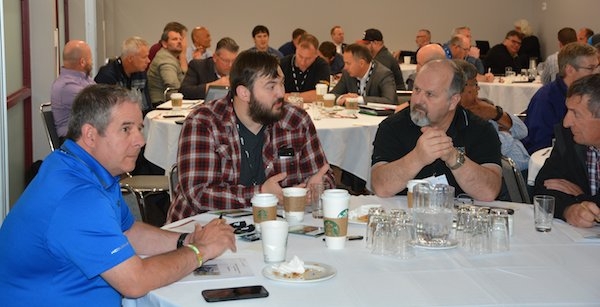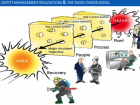
Building a world-class safe pellet industry
June 18, 2018
By Pam Agnew / BC Forest Safety Council
June 18, 2018 - The Wood Products Safety Summit 2018 offered more than 50 delegates a day of diverse presentations on safety – with a clear focus on the value of both increased collaboration and process safety.
 Some of the more than 50 delegates who attended the day-long Wood Products Safety Summit 2018 in prince George earlier this month.
Some of the more than 50 delegates who attended the day-long Wood Products Safety Summit 2018 in prince George earlier this month. Held at the Prince George Conference and Civic Centre on June 6, 2018, preceding the two-day Canadian Bioeconomy Conference and Exhibition, presenters included Scott Bax, chair of the Wood Pellet Association of Canada (WPAC)’s safety committee and senior vice-president of operations, Pinnacle Renewable Energy Inc.; Darrin McCaskill, WorkSafeBC’s director of programs, projects and initiatives; Darren Beattie, Conifex’s safety director, on behalf of the Manufacturing Advisory Group; Andy Reimer, a process safety management expert in the oil and gas sector; Alan Quilley, a safety consultant and author; Jay Juvenal, international sales manager CV Technology; and Guy Colonna, division director of the National Fire Protection Association.
[This article is part of our 2018 Dust Safety Week coverage. Find more articles here.]
There is one thing above all else that consistently permeated each of the presentations during the safety day and that was simply that process safety management, strong safety culture and high performance in any industry require collaboration, participative management of all stakeholders and a walk the talk attitude where results prove that many heads are better than one.
Kicking the day off, Darrin said that employers, workers and labour had made gains in health and safety performance, and thanks to everyone’s hard work “more workers are going home safe that at any time in our history”.
He said the multi-faceted forestry industry includes everything from harvesting, transportation, processing and manufacturing to silviculture. He noted that there are many high risk work activities involved in bringing a tree or fiber to market and the sector has seen some darker days. “The prevailing attitude at the time was not if, but when a serious incident would occur.”
Darrin said that fast forward to today and we have seen a noticeable change, a new world where employers are actively engaged in health and safety; a robust health and safety association, the BC Forest Safety Council, providing the infrastructure for health and safety and resources; and, there is an industry emphasis on training and supervision. “Clearly, the culture of risk-taking is being replaced by safety-first approach,” he said.
“We know that workers do not need to die or get hurt to cut down a tree or transport logs or manufacture lumber. Overall industry has vastly improved its safety practices; some remarkable achievements have been made and there are fewer injuries and fewer fatalities,” said Darrin. “But maybe, just maybe, good is not good enough.”
He said this was no time for complacency; one serious injury, or one fatality, is one too many; and, there are new hurdles and new risks that should be seen as challenges, but not barriers to safe and healthy workplaces. These include an aging workforce; an influx of young and inexperienced workers; increasing use of technology and new technologies; and the realities of a “contracted” work environment – the changing relationship between the employer and employee. Darrin gave the example of phase congestion and the challenges in extracting timber and getting it to processing as quickly as possible. He challenged the audience: maybe we need to be doing everything we can to be great, to be world-class, rather than just good.
He went on to discuss the characteristics of world-class organizations, emphasizing that they are not about the rule book, the OHS program, the procedures or the paperwork. Rather, “it is about the doing, the application, the practice, the action of doing and establishing the right culture for healthy and safe performance”.
In the months preceding the Nova Scotia Westray mine disaster (an underground explosion at the mine killed 26 miners on May 9, 1992) the company had won a national safety award. On paper, they had a great safety program, but what came out at the inquest is that what was happening in reality was something different – the safety program had never been fully implemented and was not fully operational. The cautionary tale shared in this and many other fatal and injury incidents is that one can be proud of the shiny binder but until safety intent is translated into action, into the “that’s how we do things around here”, it is just paper.
Darrin said that world-class organizations don’t delegate safety to one person; they have an engaged workforce where everyone feels responsible for safety; and it is the way that they do business, with CEOs and senior managers making their commitment to safety visible to all.
These organizations have operations managers who integrate safety into their business planning, and demonstrate their commitment through actions to address issues quickly and efficiently. Similarly, world-class frontline supervisors and workers know that they can report unsafe conditions without pushback.
These organizations believe in safety and establish themselves as safety leaders. They build relationships with others including the regulator. They take a risk-based approach and seek to identify key hazards and key controls and they actively seek out collaboration and joint problem solving; and are committed to continuous improvement. “Your pellet sector is on this journey,” said Darrin, citing combustible dust as an example. He explained that in 2014 the sector had a compliance rate of 40 per cent; then, a little over a year later, 90 per cent compliance, and a year after that 100 per cent compliance. Having addressed the problem of combustible dust management the sector has not stood pat but instead moved on to new challenges such as ventilation design, syngas and process safety management.
Darrin showed a WorkSafeBC video involving the Arctic Arrowline Power Company in Cranbrook, where an owner shares how his company made safety personal and underwent a significant culture change following a tragic workplace accident. Safety is personal – an employer’s story: www.youtube.com/watch?v=x9WthTBEKsw
The lessons learned include:
- that it doesn’t matter all the good things you did; it’s all the things you didn’t do that come to the fore.
- It’s about connecting with the people that you employ; translating what is in the safety binder into real practice and walking the talk.
- Grab your people; sit down and talk about safety; do safety and make it personal; and hopefully you don’t have to learn things the hard way. Darrin’s final challenge to all participants was to “leave here with a commitment to go back to your organization and make safety personal. This is how this sector will continue its journey to world-class.”
Chair of WPAC safety committee encourages increased collaboration
Scott Bax, chair of the Wood Pellet Association of Canada (WPAC)’s safety committee and senior vice-president of operations for Pinnacle Renewable Energy, said he was speaking mostly from personal opinion shaped by more than 20 years in the forestry business as well as a little from both WPAC and Pinnacle perspectives.
He said that collaboration makes us better as an industry and in search of continuous improvement, we needed to focus on finding opportunities to learn and one such opportunity was finding where process safety fits in.
“Leading in safety means that we don’t compete on safety. Every member of WPAC commits to that. We will share anything with anyone, anytime, anywhere. We can compete on many other things but safety is not proprietary; and I think we can do more,” said Scott.
Quoting Ken Blanchard, the internationally acclaimed leadership and management expert, Scott said “none of us is as smart as all of us”.
Scott shared many examples of collaboration – from conferences, key groups like the Manufacturing Advisory Group (MAG) and WPAC, the health and safety association – BC Forest Safety Council, regulators – WorkSafeBC, Technical Safety BC and the Fire Commission; insurers and vendors; and other one-on-one subject-specific experts to crews’ feedback and joint occupational health and safety committees, etc.
He said that every stakeholder brings a unique perspective and expertise and it was important to have a willingness to listen respectfully and understand that point of view. Together industry can best increase the pace at which leading practices can be identified and implemented to secure continuous improvement in safety outcomes.
“There are always opportunities to learn,” said Scott, adding that it was important to remain focused on a risk-based approach, recognizing that 20 per cent of the work creates 80 per cent of the risk in wood products manufacturing.
In addition to safety leadership, advanced training, safety culture, investigations, making and keeping safety personal for all workers — process safety management is another tool. “It has the ability to make us better and is a tool that has not been maximized by industry in the past,” said Scott.
He said Pinnacle had chosen to implement process safety management because it could make their operations safer. WPAC also believes that using process safety management can make a difference and bring more people home safe. Scott says it is not about reinventing the wheel, but rather seeking sustainable execution by building on existing strengths.
“As an association, we are providing access to the tools. We are not being prescriptive to members. They can adapt to use what makes sense and at the timing that works best for their organizations,” said Scott.
He said there was a lot to be learned from the oil and gas industry that could be applied to forest product manufacturing. Below are two slides that summarize process safety.
This diagram depicts a “Swiss cheese” model devised by James Reason. It starts with a hazard (top right) ends with an incident (bottom left). The holes in the Swiss cheese line up perfectly to allow a hazard to transform into a catastrophic event. Process safety management addresses potential hazards early in the process, optimally at the design stage. It also looks at how people interact with the different systems (e.g. operator training, human machine interface, control designs, alarms, redundancies, etc.).
While personal and process safety differs, some common elements are shared. Personal safety tends to focus on administrative and PPE type solutions, relying heavily on both the worker and the supervisor. In comparison, process safety starts at the elimination/substitution and engineering hierarchies, with the majority of the responsibility being on management and engineers.
WPAC, working with ACM – process safety management experts (www.acm.ca/) – have rolled out three modules so far to members: process hazard analysis; management of change; and documentation; with two more modules coming in 2018: investigations, and due diligence.
In summary, Scott said that as an industry, we have opportunities to be better: “Working together means we can be stronger. Collaborate with everyone and collaborate more.”
Building a collaborative industry forum
Manufacturing Advisory Group (MAG) member and Conifex’s safety manager, Darren Beattie, provided an update on B.C.’s new Forest Industry Forum, on behalf of MAG.
He said that the new Forest Industry Forum was a model that allowed for an all-inclusive consultative and collaborative forum between industry, the regulator and labour, with one shared focus: to bring about the best solutions for improved safety outcomes.
Darren shared how the latest forum had come about, going back to the 2012 Lakeland and Babine explosions; subsequent fatality inquests; and then the Macatee Report.
While industry has previously worked with the regulator on safety matters, things had come to a point that there needed to be a process for consultation and collaboration with industry, labour, and the regulator on safety issues. He said the initial forums had become less effective over time because the structure and format of those forums was not designed for collaboration. As a result, he and Matt Franks, another MAG member and Canfor’s safety manager, had been charged by MAG to consult with WorkSafeBC on a process to address a need for sustained collaboration that would allow the building of a strong working relationship between industry, the regulator and labour to fully address emerging issues, risk reduction and compliance.
With better communications, collaboration and shared commitment between the three groups to solve challenges, they have developed a more efficient and effective process built on broad, qualified stakeholder input and engagement that they all believe will lead to improved safety standards and performance.
The framework has evolved away from looking at areas of concern to forming technical working groups – manufacturing and harvesting working groups. Both MAG and WPAC feed into the technical manufacturing working group.
While the groups meet quarterly, they communicate constantly on current and emerging issues.
Darren explained that the participants on the manufacturing side included safety leaders from industry, labour, WorkSafeBC and the BC Forest Safety Council; and that there was equal representation on the harvesting side as well.
In regards to harvesting, the focus is on addressing fatigue, load securement, self-loading truck guarding and phase congestion. On the manufacturing side, the focus is on the Part 12 regulation section review on safeguarding and the conflict between lockout and safeguarding, high risk strategy updates and wood fibre storage.
Darren said the safeguarding technological advancement initiative, undertaken at Conifex, and supported by MAG and WorkSafeBC, had identified conflict within the regulation. The ultimate goal is to enable regulation to be formulated and implemented properly, which requires input, consultation and shared understanding in the early phases of testing and implementation. “There is an opportunity for industry to give input very early on in the process which is very important,” said Darren.
Meetings have been scheduled for the rest of 2018 including planning for the annual forestry summit as well as a part 12 review of regulations re safeguarding.
“We have one goal,” said Darren. “We are not there to lobby for any specific interests. We are there to find ways to achieve safer outcomes that see everyone go home safe.”
Print this page





